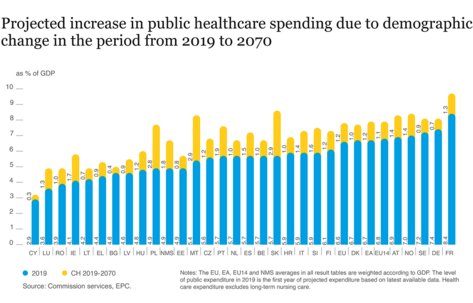 iStockphoto / ipopba
iStockphoto / ipopba
Health
ed* Nr. 02/2021 – Chapter 6
Health spending1 as a share of GDP in 2018, hit a European average of 10 per cent. Of this, 7.8 percentage points is public spending whereas the figure is 8.9 per cent in Germany. Healthcare costs increase from the ages of 55 for men and 60 for women. Demographic change may become a cost driver for health spending if it is not possible to counter this and give people more healthy years. This is where the commitment of the social insurance funds to design efficient health care and to strengthen prevention comes in. Medical progress had a far greater effect in the past than demographic factors.
The average European cost increase is calculated at 0.9 percentage points –- up from 6.6 to 7.5 per cent of GDP. In contrast, it is only 0.4 percentage points for Germany – almost at the lowest end of the comparative scale – up from 7.4 to 7.8 per cent of GDP. This might also be related to the relatively high proportion of privately insured persons. It is assumed that the insured collectives of private insurance age grow faster than those of statutory health insurance – not least because of the more difficult access to private insurance. As the ageing report explicitly points out, this reduces the burden on the public sector.

As already indicated – different assumptions about whether additional years of life gained will be spent in good or poor health had a major impact on the result. If it will be good health, then the projections are much more favourable; in the case of Germany, as public spending on health (as a proportion of GDP) is even projected to fall. However, if conceivable non-demographic cost drivers are considered, such as innovations in the healthcare sector or a change in demand behaviour, then the values are significantly worse than in the purely demographic, basic scenarios. The average European increase would be 3.1 percentage points, whereas it would be 2.5 percentage points for Germany.
The report concludes at this point by saying that demographic and non-demographic factors will continue to exert huge pressure on the sustainability of publicly financed health expenditure in the future. The public sector will continue to bear the main share of healthcare costs in the future.

